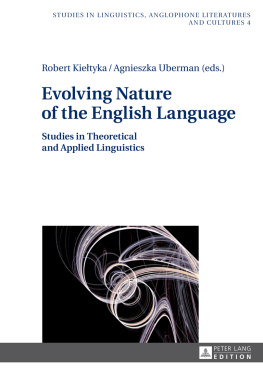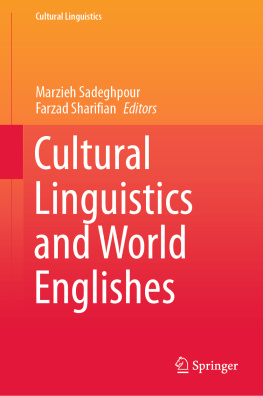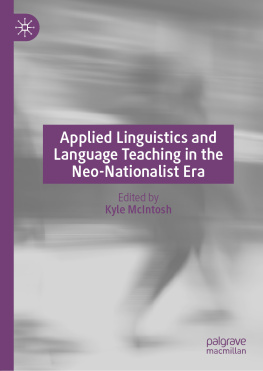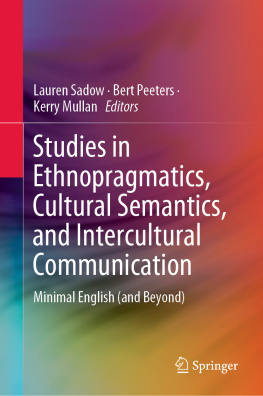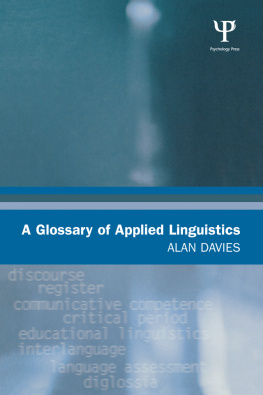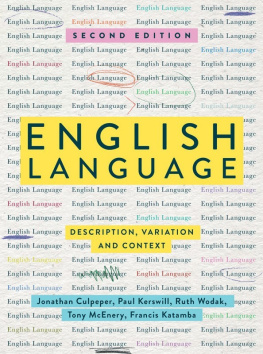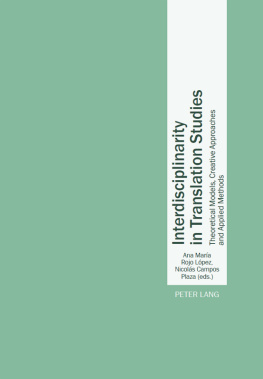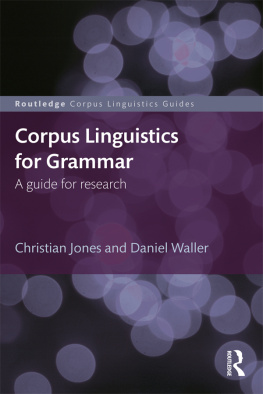Table of Contents
Page List
STUDIES IN LINGUISTICS, ANGLOPHONE
LITERATURES AND CULTURES
Edited by Robert Kietyka and Agnieszka Uberman
Advisory Board:
Piotr P. Chruszczewski (Wrocaw, Poland)
Grzegorz A. Kleparski (Rzeszw, Poland)
Zoltn Kvecses (Budapest, Hungary)
Anna Malicka-Kleparska (Lublin, Poland)
Sndor Martsa (Pcs, Hungary)
Tadeusz Rachwa (Warsaw, Poland)
Elbieta Rokosz-Piejko (Rzeszw, Poland)
Slvka Tomasckov (Koice, Slovakia)
VOLUME 4
Notes on the quality assurance and peer review of this publication
Prior to publication, the quality of the work published in this series is
reviewed by the editors and members of Advisory Board of the series.
Robert Kietyka / Agnieszka Uberman (eds.)
Evolving Nature of the
English Language
Studies in Theoretical and Applied Linguistics
Bibliographic Information published by the Deutsche Nationalbibliothek
The Deutsche Nationalbibliothek lists this publication in the Deutsche Nationalbibliografie; detailed bibliographic data is available in the internet at http://dnb.d-nb.de.
This publication was financially supported by the University of Rzeszw.
Cover Illustration courtesy of Benjamin Ben Chaim.
Reviewed by Teodor Hrehovk and Anna Malicka-Kleparska
ISSN 2364-7558
ISBN 978-3-631-67625-7 (Print)
E-ISBN 978-3-653-06993-8 (E-PDF)
E-ISBN 978-3-631-70407-3 (EPUB)
E-ISBN 978-3-631-70408-0 (MOBI)
DOI 10.3726/978-3-653-06993-8
Peter Lang GmbH
Internationaler Verlag der Wissenschaften
Frankfurt am Main 2017
All rights reserved.
Peter Lang Edition is an Imprint of Peter Lang GmbH.
Peter Lang Frankfurt am Main Bern Bruxelles New York Oxford Warszawa Wien
All parts of this publication are protected by copyright. Any utilisation outside the strict limits of the copyright law, without the permission of the publisher, is forbidden and liable to prosecution. This applies in particular to reproductions, translations, microfilming, and storage and processing in electronic retrieval systems.
www.peterlang.com
About the author(s)/editor(s)
Robert Kietyka is Associate Professor at the Institute of English Studies, University of Rzeszw (Poland). His main research interests include diachronic semantics, cognitive linguistics and morphology-semantics interface.
Agnieszka Uberman is Associate Professor at the Institute of English Studies, University of Rzeszw (Poland). Her main research interests include applied linguistics, cognitive linguistics and figurative language use.
About the book
This volume presents a collection of interdisciplinary papers pertaining to the most thought-provoking problems in the areas of both theoretical and applied linguistics. The contributors focus on contemporary developments in morphological, semantic and pragmatic theorizing. The contributions are also devoted to various aspects of the methodology of teaching English as well as some intricacies of translation.
This eBook can be cited
This edition of the eBook can be cited. To enable this we have marked the start and end of a page. In cases where a word straddles a page break, the marker is placed inside the word at exactly the same position as in the physical book. This means that occasionally a word might be bifurcated by this marker.
| 7
The monographic study Evolving Nature of the English Language: Studies in Theoretical and Applied Linguistics presents a collection of insightful papers pertaining to the most thought-provoking problems in the areas of both theoretical and applied linguistics. The current volume comprises twenty chapters, organized into two parts.
Part I, Studies in Theoretical Linguistics, consists of twelve chapters devoted primarily to contemporary developments in morphological, semantic and pragmatic theorizing. The opening chapter, written by Ada Bhmerov, touches upon the problem of Latinisms in substandard Slovak. The author expresses the view that countless Latinisms have found their way into Slovak lexis, while many others are constantly being added to it as Neo-Classicisms. They are also shared with other languages as internationalisms. Among other things, the results of the research show that the presence, distribution, semantic content and communicative and pragmatic status of Latinisms in the lexical systems of Slovak and English are marked by various and complex differences.
The next chapter, written by Piotr Cymbalista, is devoted to a discussion of the semantic development of occupational names in English. The author would appear to reach the conclusion that terms denoting jobs, professions and occupations are a very potent source of the conceptualizations responsible for one clearly discernible pattern of semasiological development, namely that of the WORKER MACHINE/IMPLEMENT. The analysed pattern of metaphorical lexical sense development may be explained through the influence of extralinguistic context on meaning conceptualization. In turn, Yuliya Davydyuk carries out an analysis of the mechanism of Conceptual Blending in Virginia Woolfs Lappin And Lapinova. The author discusses the identity of the main characters with their alter egos, integration of all the events of the story and all the possible states and conditions of the main characters. The analysis also considers the role of imagination in creating the images of the protagonists which allows the reader to identify and integrate with the mental lives of the main characters.
The problems arising during the discussion of Londons linguistic capital in urban visual signs are portrayed by Guntars Dreijers. In the authors view, texts in Londons visual signs appear in different formats, and they usually perform informative and vocative functions which elicit answers to questions of what the city talks about and how it creates urban narratives. The next chapter, authored by Robert Kietyka, sheds some light on the complexity of the mechanism of zoosemy 7 | 8 in relation to its extension into the category VERB. It is devoted to the discussion of the mechanics of metaphor-metonymy interaction couched in terms of the theory of conceptual metaphor and metonymy where animal-related verbs are used with reference to human beings or those qualities and actions that are related to human beings. In turn, Grzegorz A. Kleparski, in his cognitively-oriented text, pursues the problem of phraseologically embedded spectral zoometaphors. Having considered a number of historically substantiated senses of dog in the context of the phraseologically embedded spectral senses singled out in the chapter, the author comes to the conclusion that they have much in common, and not infrequently the senses overlap, which may explain the historical centrality of certain senses and the marginal nature of others.
Marcin Kuda, in another study couched in cognitive terminology and devoted to the analysis of the semantic evolution of attributive ethnonyms argues, among other things, that stereotypes are shared within a culture, but at the same time they operate simultaneously on the cognitive level, since they are products of the mind. In the authors view, a linguistic analysis may bring us closer to identifying the most salient elements of particular stereotypes and possibly to uncovering the general mechanisms which determine the formation, use and evolution of stereotypes. The chapter authored by

